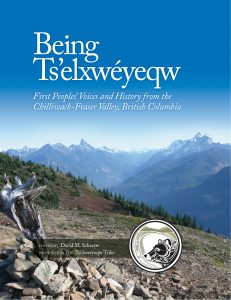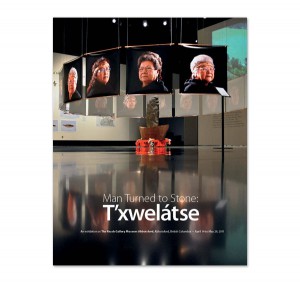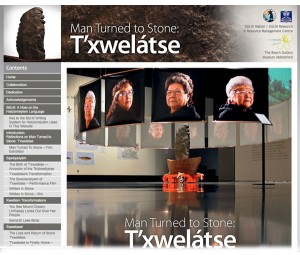This is video put out by Friesens, an excellent Canadian book printer, that explains the entire process of printing a book. If you’ve ever wondered what the process is in creating and producing a printed book, this provides a good demonstration.
Friesens Book Division Video
Being Ts’elxwéyeqw

This new book that is produced by the Ts’elxweyeqw Tribe, uses design by Jan Perrier was published in January 2018. One feature of this book is that Dave Schaepe (the editor) wanted to avoid chapter numbers that indicated a hierarchy or importance of order. Instead we conveyed the sense of location in the book through the use of colour bars which are on the table of contents but also run down the side of the book pages. I have been very fortunate to have worked on these types of projects which include cartography and design. Here is a description and reviews about the contents from the back of the book:
BEING TS’ELXWÉYEQW provides an in-depth and personal view of the First Peoples of the Chilliwack River Watershed in the Central Fraser Valley, British Columbia. This book focuses on two key questions – what does the word Ts’elxwéyeqw mean? And, what does it mean to be Ts’elxwéyeqw, as a tribe of Stó:lō-Coast Salish People? Presented here are key narratives of the distant past and personal histories; over 700 historic and contemporary photographs, maps and images of Ts’elxwéyeqw people, places and belongings; and more than 85 place names within the Chilliwack Watershed that help convey answers to these core questions. This is an original volume with an arrangement and presentation of voices of Elders past, present and future. It contributes to achieving a better relationship and understanding of how to live together in a good way in today’s world.
For more information about the project, please contact the Stó:lō Research and Resource Management Centre
To purchase a book, you can contact the publisher: Harbour Publishing
REVIEWS
“The way this book is put together reminds me of the way the Elders talked to me when I was growing up. They would give you part of something and let you figure out the rest.
It represents a traditional Coast Salish education model. It may be challenging to some of our young people, but it is important to bring back our way of doing things, including teaching and learning.”
T’xwelátse (Herb Joe),
Tzeachten First Nation member, Cultural Practitioner, University Instructor and Social Worker
“In its many voices, this powerful book confirms the long and ongoing occupation of today’s Chilliwack Valley by the Ts’elxwéyeqw people. Readers will come away with a deep appreciation of the depth of the Tribe’s connection to this place and their continuous governance of it. Most of all, they’ll be impressed by the enduring distinctiveness of Ts’elxwéyeqw culture in the face of sometimes extreme pressures.”
J.B. MacKinnon,
Acclaimed Author and Journalist
“THIS VOLUME IS A RICH, challenging, and visually compelling montage of Indigenous history and contemporary experience in the Fraser Valley. For settlers, this material may open up vistas to understanding their Stó:lō neighbours. For Ts’elxwéyeqw, it may serve this same purpose within their own community at the same time as representing a validation and culmination of stories, images, and landscapes known since childhood.”
Natasha Lyons,
Anthropologist / Archaeologist, Ursus Heritage Consulting / Simon Fraser University
“BEING TS’ELXWÉYEQW EMPHASIZES IMAGERY and the voices of past and present community members, while avoiding a master narrative. Many of the passages are fascinating and moving. The volume sets out to make clear what it means to belong to a particular tribe. This is done suggestively and by showing the connections between identity, land and water, ancestry, and culture. In conformity with Coast Salish culture, there is a larger meaning to the text and everyone will understand in their own way. And the publication has virtuosity—it reveals and is based on many years of work and deep connection to the community by the editor and the deep participation of the community in the project.”
Bruce Granville Miller,
Professor, Department of Anthropology, University of British Columbia
Man Turned to Stone: T’xwelátse
Man Turned to Stone: T’xwelátse brings to life a remarkable story of loss and repatriation. At its heart is a message of collaboration and cooperation between cultures and communities.
In the spring of 2011, the Reach Gallery Museum Abbotsford in collaboration with the Stó:lo Research & Resource Management Centre, artists David Campion and Sandra Shields created this exhibition that told the story of Stone T’xwelátse.
Their was a strong desire on the part of this team to get the information and images from the exhibition out to the public. Through grants provided by Heritage Canada, The Canada Council for the Arts and the British Columbia Arts Council, there were funds to produce a book about the exhibit. My first role in this project was to help in the designing & printing of the book. It is a 11″ x 14″ paperback (ISBN 978-0-9879661-0-0) and gives you the history behind T’xwelátse and his message which is still pertinent today “We must all learn to live together in a good way”.
After the book was published, we moved onto designing a website that was basically a mirror image of the book but worked like a virtual book that can be updated as times change and more information becomes available. I have built ebooks, but this is the first time that I’ve turned a book into a website and it was a valuable experience. Aside from the text and images included in the book, you’ll also be able to view the film “T’xwelátse Is Finally Home” and more videos that help to convey the history and meaning of T’xwelátse’s story. You can download a free copy of the printed book by clicking on this link (25 mb file).
There was one more thing to be done to complete the project and that was to do some advertising to let people know about the exhibit, book and the virtual book website. To that end we created a press release, with the writing skills of the talented Naomi Pauls of Papertrail Publishing (who also did the editing on the book). The press release was sent out on August 2, 2012 to the lower mainland BC media as well as aboriginal media across Canada. We also designed and published ads on websites that we thought would give the best exposure to the project.
I get such pleasure from the interesting people I meet through my work. I’ve been fortunate in working on quite a few projects revolving around the rich history of our aboriginal people and always feel so lucky to be a part of passing their history on… this project was no exception. Many history books in the past were written from a European point of view, so it’s wonderful to see the history of the people who have been here from time immemorial being shared with the general public. Here is a quote from the book and website that explains T’xwelátse’s transformation:
“T’xwelátse and his wife were on the riverbank arguing when Xá:ls happened upon them. Xá:ls, the great Transformer being given the responsibility by Chíchelh Siy:ám for making things right as he travelled through our lands, asked this man and woman if they would consider not arguing and that there were better ways of resolving conflict and resolving problems. As a result of his intervention Xá:ls and T’xwelátse, who was a shaman, decided to have a contest. They tried to transform each other into various things—a salmon, a mink, a twig. Finally, Xá:ls was successful in transforming T’xwelátse into stone. Xá:ls then gave the responsibility of caring for Stone T’xwelátse to T’xwelátse’s wife. Stone T’xwelátse was to be brought home and placed in front of their house as a reminder to all of the family that we have to learn to live together in a good way. And the family’s responsibility from that point in time was caring for Stone T’xwelátse—given to one of the women of our family. They were to be the caretaker of Stone T’xwelátse throughout their lifetime and would pass it on to one of their daughters or granddaughters, who would then be responsible for caring for Stone T’xwelátse for that generation.”
—As told by T’xwelátse (Herb Joe), 2003
I encourage you to visit the website, to read about “Man Turned to Stone: T’xwelátse” and watch the videos. I can’t think of anywhere else where you could read the story of a man turned to stone, but who is still considered to be a living being. It’s an unique opportunity to learn and explore this fascinating story.
Allowances, Dollars & Sense
I had the pleasure of designing this book cover, interior and ebook for Paul Lermitte. It was a great project as it involved illustration as well as design. We spent a bit of time going back and forth with ideas for the cover illustration and I think we came up with a good concept in the end.We decided to use a piggy bank as it’s an easily recognizable tool for saving money and something all ages can relate to.


Paul Lermitte has created this first in a series of four books titled the “Family Finance” series. Allowances, Dollars & Sense is full of practical advice about raising your children to learn how to save money and achieve their goals. For more information about the books go to:
http://www.paullermitte.com/books/book-one-allowances-dollars-and-sense
The book is available as a paperback or epub.
UPDATE 2017: Paul has now added two new books to this series, Dreams, Dollars and Sense for helping teens manage their finances and Decisions, Dollars and Sense, targeted at the young adult market. These books can be purchased on Amazon or through Paul’s website.

